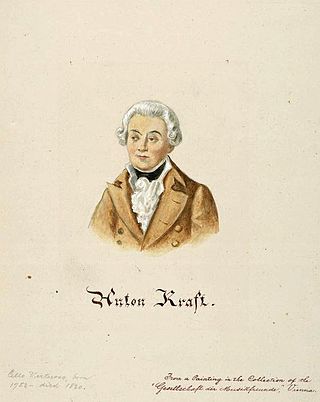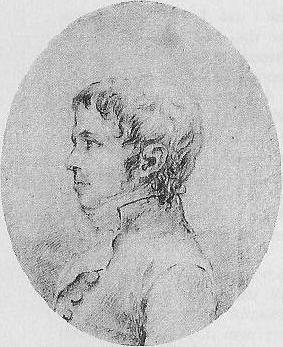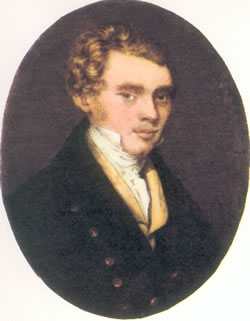
Chamber music is a form of classical music that is composed for a small group of instruments—traditionally a group that could fit in a palace chamber or a large room. Most broadly, it includes any art music that is performed by a small number of performers, with one performer to a part. However, by convention, it usually does not include solo instrument performances.
This is a list of music-related events in 1808.

Count Andrey Kirillovich Razumovsky was a Russian Imperial diplomat who spent many years of his life in Vienna. His name is transliterated differently in different English sources, including spellings Razumovsky, Rasumofsky, and Rasoumoffsky.

Ludwig van Beethoven completed his String Quartet No. 12 in E♭ major, Op. 127, in 1825. It is the first of his late quartets. Commissioned by Nicolas Galitzin over a year earlier, the work was not ready when it was scheduled to premiere. When it finally premiered by the Schuppanzigh Quartet, it was not well received. Only with subsequent performances by the Bohm Quartet and the Mayseder Quartet did it begin to gain public appreciation.

The Grosse Fuge, Op. 133, is a single-movement composition for string quartet by Ludwig van Beethoven. An immense double fugue, it was universally condemned by contemporary music critics. A reviewer writing for the Allgemeine musikalische Zeitung in 1826 described the fugue as "incomprehensible, like Chinese" and "a confusion of Babel". However, critical opinion of the work has risen steadily since the early 20th century and it is now considered among Beethoven's greatest achievements. Igor Stravinsky described it as "an absolutely contemporary piece of music that will be contemporary forever".

The Cello Sonata No. 3 in A major, Op. 69, is the third of five cello sonatas by Ludwig van Beethoven. He composed it in 1807–08, during his productive middle period. It was first performed in 1809 by cellist Nikolaus Kraft and pianist Dorothea von Ertmann, a student of Beethoven. Published by Breitkopf & Härtel the same year, it was dedicated to Freiherr Ignaz von Gleichenstein, Beethoven's friend and an amateur cellist. The sonata was successful with audiences from the beginning.

Ignaz Schuppanzigh was an Austrian violinist, friend and teacher of Beethoven, and leader of Count Razumovsky's private string quartet. Schuppanzigh and his quartet premiered many of Beethoven's string quartets, and in particular, the late string quartets. The Razumovsky quartet, which Schuppanzigh founded in late 1808, is considered to be the first professional string quartet. Until the founding of this quartet, quartet music was played primarily by amateurs or by professional musicians who joined together on an ad hoc basis.

The Cello Concerto Nr. 1 in C Major (Op.4) is a cello concerto by Antonín Kraft.

The Hellmesberger Quartet was a string quartet formed in Vienna in 1849. It was founded by Joseph Hellmesberger Sr. and was the first permanent named String Quartet.

Antonín Kraft was a Czech cellist and composer. He was a close friend of Haydn, Mozart, and Beethoven.

Joachim Nicolas Eggert was a Swedish composer and musical director.

Joseph Böhm was a Hungarian violinist and a director of the Vienna Conservatory.

Leopold Jansa was a Bohemian violinist, composer, and teacher.

Joseph Merk was a noted Austrian cellist, often described as one of the most influential of the first half of the 19th century. He also wrote a number of compositions for the cello.

Joseph Mayseder was an Austrian violin virtuoso and composer.

The three String Trios, Op. 9 were composed by Ludwig van Beethoven in 1797–98. He published them in Vienna in 1799, with a dedication to his patron Count Johann Georg von Browne (1767–1827). They were first performed by the violinist Ignaz Schuppanzigh with two colleagues from his string quartet. According to the violinist and conductor Angus Watson, these were probably Franz Weiss on viola and either Nikolaus Kraft or his father Anton on cello. Each of the trios consists of four movements:
Joseph Linke was a cellist and composer who had a distinguished career in Vienna, as a soloist and as a member of the Schuppanzigh Quartet. He took part in the first performances of string quartets and other chamber works of Ludwig van Beethoven and Franz Schubert.

Karl Holz was an Austrian violinist. He played second violin in Ignaz Schuppanzigh's string quartet and served as secretary to Ludwig van Beethoven during the last few years of the composer's life.

Prince Nikolai Borisovich Galitzin (Russian: Николай Борисович Голицын, was a Russian aristocrat, of the Galitzin family. He was an amateur musician, and is known particularly for his commissioning three string quartets — opp. 127, 130 and 132 — from Ludwig van Beethoven, which are among the composer's group of late string quartets.
Franz Weiss was an Austrian violinist and viola player, and a composer. He is known particularly as a viola player in the Schuppanzigh Quartet, which was associated with the string quartets of Ludwig van Beethoven.


















